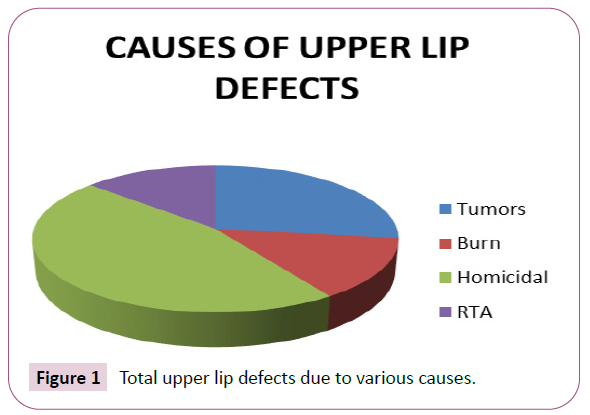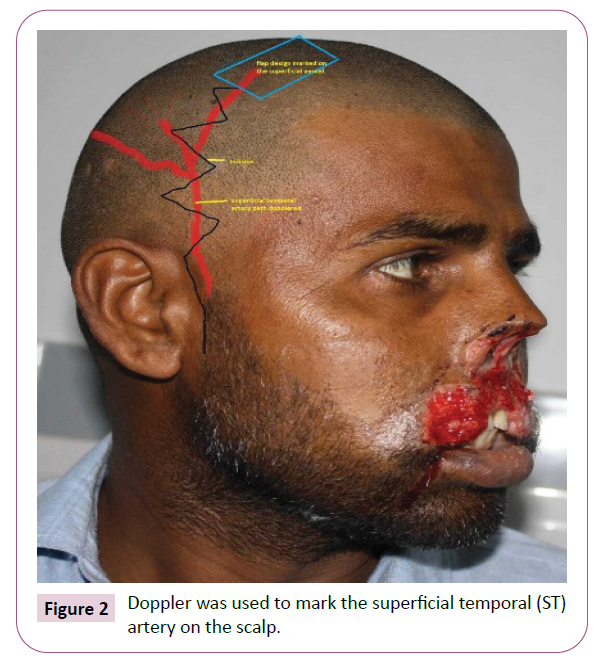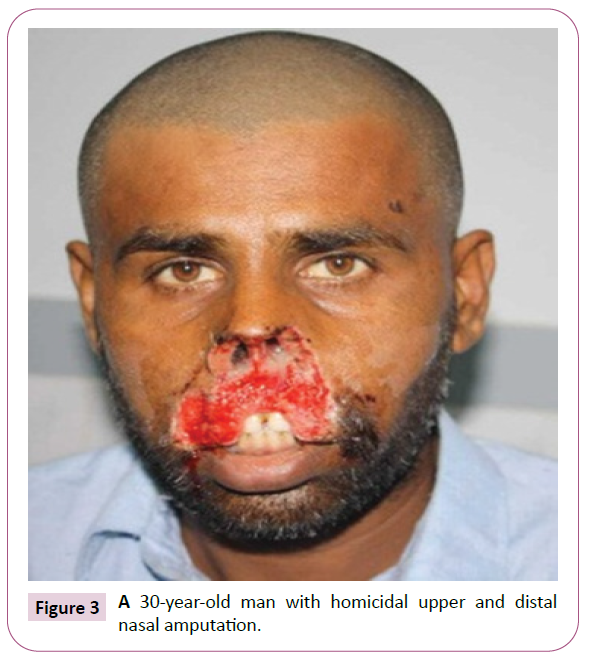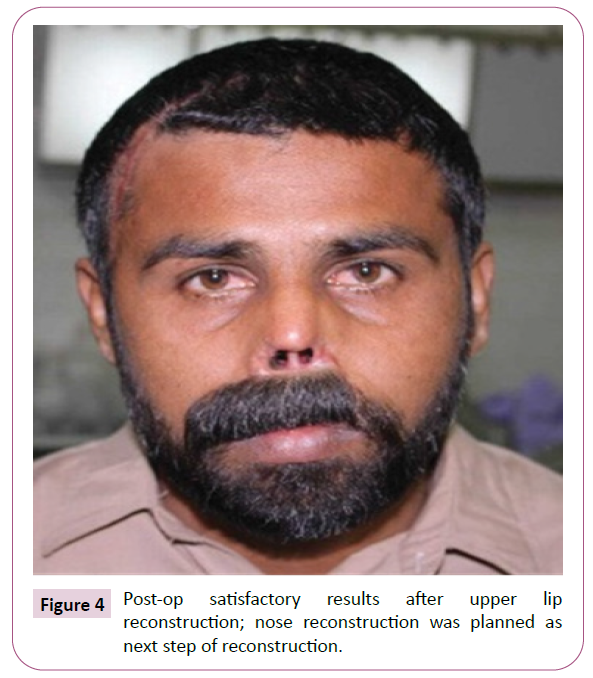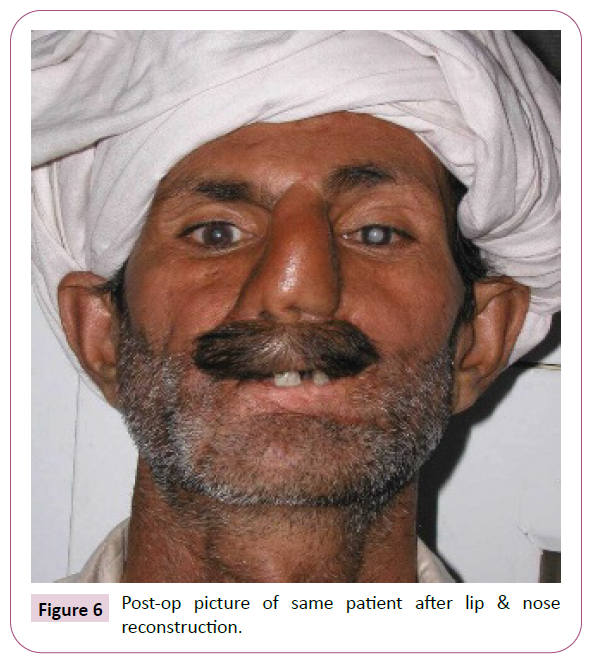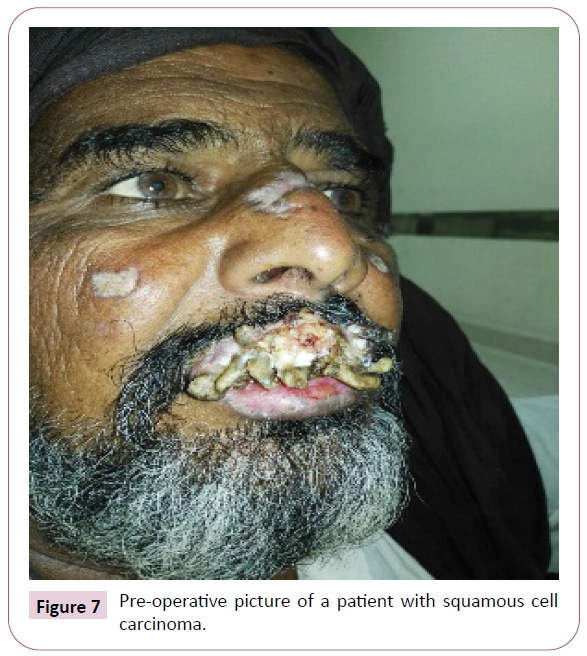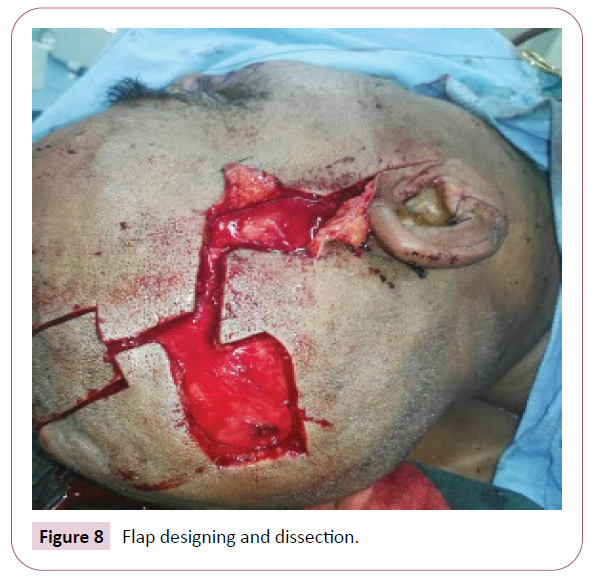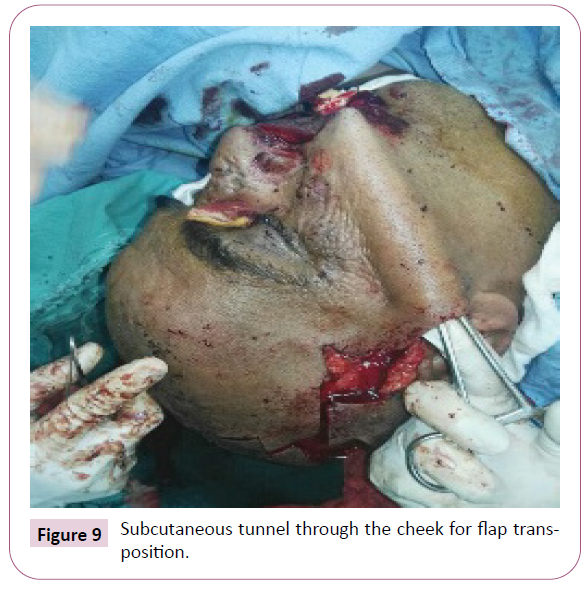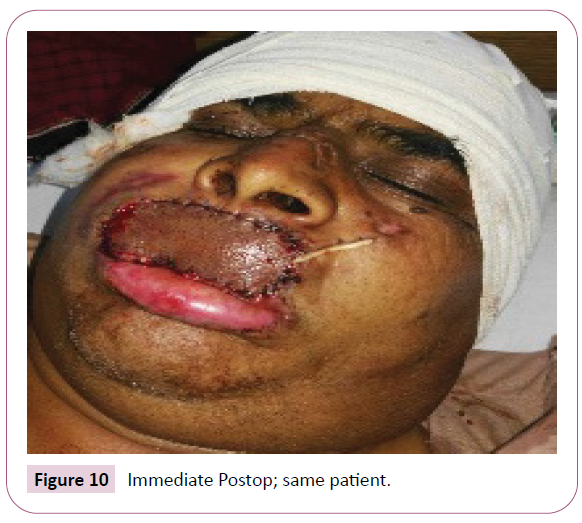Islanded Superficial Temporal Artery Flap for Single Stage Reconstruction of Large Upper Lip Defects in Male Patients
Akashah Ambar *, Uzma Naseer, Javarria Mahmood, Gul-e-Rana Malik, Farhat-ul-Ain Tayabba, and Muhammad Mughese Amin
Department of Plastic Surgery, Bahawal Victoria Hospital, Bahawalpur, Pakistan
- *Corresponding Author:
- Dr. Akashah Ambar, MBBS, FCPS
Department of Plastic Surgery
Bahawal Victoria Hospital
Bahawalpur, Pakistan
E-mail: akasha.amber@gmail.com
Received Date: July 14, 2021; Accepted Date: August 07, 2021; Published Date: August 14, 2021
Citation: Ambar A, Naseer U, Mahmood J, Malik GR, Farhat-ul-Ain T, et al. (2021) Islanded Superficial Temporal Artery Flap for Single Stage Reconstruction of Large Upper Lip Defects in Male Patients. J Aesthet Reconstr Surg Vol.7 No.5:37
Abstract
Recreating a normal looking and optimally functioning upper lip is a challenge for a reconstructive surgeon. Motor vehicle accidents, homicidal amputations, burn and cancer are major causes of upper lip defects. Often multiple staged procedures are required to achieve the goals. Islanded superficial temporal artery flap is a single stage procedure to reconstruct a near normal looking upper lip camouflaged with moustaches for the male population. We have an experience of reconstructing 35 cases of upper lip defects resulting from trauma, homicidal amputations, burn and post-oncological resection, with the above said procedure and were able to achieve excellent results. We used hand held Doppler to identify the superficial temporal artery, raised an islanded flap, tunneling through the cheek, transposed it to the upper lip defect. Results fulfill the criterion of an aesthetically pleasing and functionally competent lip. Complication rate is nearly negligible.
Keywords
Lip; Trauma; Reconstruction; Islanded superficial temporal artery flap
Introduction
Perioral area is important both functionally and cosmetically. Its mobile nature and varied contours make it a reconstructive challenge. The lips are a focus of facial beauty, and their central location does not permit concealment of unsightly scars or asymmetrical results [1].
The principles of midface reconstruction are to achieve adequate function as well as normal aesthetics. The massive destruction that is associated with infections, tumors, trauma, and thermal injuries, even surgical resection itself, results in significantly disfigured three-dimensional (3D) defects that are challenging during reconstruction due to the amount of the tissues involved, including cheek, nose, and upper lip, all of which require reconstruction [2]. All the procedures involved make reconstruction of either or both the upper and lower lips, and an achievement of good functional and aesthetic results a daunting task [3].
The oral sphincter has some fundamental functions i.e., phonation, food and saliva retention, facial expressions such as anger and smile and a satisfactory cosmetic appearance [4]. There are numerous options in our armamentarium to achieve the reconstruction of upper lip defects as well as for midface defects [3], including local, regional and microvascular free flaps.
The local and regional flaps do not usually provide an adequate amount of support, coverage or lining for large defected areas, even though, there would be good color and texture match. Moreover they cause significant microstomia. The conventional free flaps [5] are not sufficient enough to replace the original multilayered facial structures, besides these are time consuming and require microsurgical expertise and facilities.
The superficial temporal artery is one of the two terminal branches of external carotid artery. It supplies the temporo-parietal fascia and the adjacent scalp [6]. Multiple flaps can be based on this vessel for reconstruction in the head and neck region. This artery is easily identifiable & readily accessible by a simple pre-auricular incision. There is negligible donor site morbidity.
Patients and Methods
A total of 35 patients met the inclusion criteria of our study and were registered. All of them were males, aged between 20-70 years (mean age 45), having 70% to near total upper lip defects due to various causes (Figure 1). This was a retrospective study, conducted in the department of Plastic & Reconstructive Surgery, Bahawal Victoria Hospital, Bahawalpur, spanning over a period of 4 years (from 2016 to 2019). The cause of the defect was noted.
Any co-morbid condition like diabetes mellitus, hypertension and smoking were noted as well. Informed consent was obtained from all the patients according to the Declaration of Helsinki and IRB approval was obtained from the department of the institution. Islanded superficial temporal artery flap was used in all these patients.
Flap marking and harvesting
First of all, the defect was measured and the template was made and sterilized. The Doppler was used to mark the superficial temporal (ST) artery on the scalp (Figure 2). The template was then placed over the ST artery and flap was marked. A straightline incision was marked in pre-auricular region and a zigzag incision in the hair bearing skin on the scalp. The flap was raised in the subgaleal plane and ST vessels were incorporated in the flap. A subcutaneous tunnel was made in the cheek. The flap was passed through this tunnel. Care was taken to keep the hair directed downwards in the recipient area.
Flap insetting
The lower margin of the flap was sutured with the remaining oral mucosa. Care was taken while passing through the tunnel to avoid any kinking of the vascular pedicle. The upper margin of the flap was sutured with the left over skin margin. A small drain was placed for 1-2 days.
The patients were monitored carefully in the post-op period. The patients were discharged after 6-7 days and a regular follow-up was ensured. Any complication arising was noted and managed accordingly.
Results
A total of 35 patients were included in the study. The mean age of the patients was 45 years (range, 20 - 70 years). All the patients had more than 50% of the upper lip defect. Homicidal lip injury was the main cause (48.5%) followed by tumor (28.6%), burns (14.3%) and road-traffic accident (8.6%) (Figures 3-6).
The homicidal upper lip injury also included partial nasal amputations. The tumors included squamous cell carcinoma (Figure 7). The average size of the flap was 2.5 cm x 7.5 cm. The patients did not show any complication during the post-op period. The patients were asked about the satisfaction about 6-7 months after the procedure and all were very satisfied.
Case 1: A 30 years old male presented in emergency with homicidal upper lip amputation. The examination revealed the involvement of more than 70% upper lip amputation with distal nasal amputation. The islanded superficial temporal artery flap was used to cover the defect and upper lip defect. The patient was satisfied with the outcome.
Case 2: A 55 years old male came as out clinic patient with healed defect after traumatic amputation of his upper lip and distal nose amputation. Lip reconstruction followed by nasal reconstruction was performed successfully.
Case 3: A 50 years old male presented with squamous cell carcinoma involving upper lip. The patient underwent resection of the tumor and the defect was reconstructed with islanded superficial temporal artery flap.
Discussion
Massive midface defects that involve the lip(s) can pose challenging reconstructive problems. This region being the focus of viewers’ eyes makes the cosmetic outcome of its reconstructions more important than those of any other region of the body. Free tissue transplantation is the preferred method to reconstruct massive dentofacial defects, and local tissue should be used wherever possible [5,6].
The lips are considered the central feature of the face. It is difficult to reconstruct lip defects as they are complex structures composed of muscle, fat, vermilion, mucosa, and skin. When performing reconstruction, it is best to use identical or similar tissues while camouflaging the scars as much as possible. When a plastic surgeon attempts to perform reconstruction of massive midface defects, including large upper lip defects, it is necessary to make careful preoperative plans in order to restore functions and appearances. Generally, for lip reconstruction, defects involving less than a third of the lip can be closed primarily. If the defect is large (30 to 80%), Estlander, Abbe, or Karapandzic flaps are used [7,8]. Moreover, if the surgeon decides to reconstruct larger lip defects with local flaps, one must consider the disadvantages of rotating large amounts of local tissue including facial disfigurement, microstomia, and often unfavorable scars (Figure 8).
Regional flaps like forehead, scalp, submental are fewer options described in literature but all have their own set of disadvantages. The use of free tissue transfer for lip reconstruction is a very predictable method for reconstructing these challenging defects and maintaining a patient's ability to take in an oral diet [9].
Radial forearm free flap is the most commonly used free flap for lip reconstruction [9]. Other options include anterolateral thigh free flap, superficial temporal artery free flap and many others but free flaps are time consuming and require microsurgical expertise and setup [10,11]. All other treatment options like radial forearm free flap, nasolabial flap, karapandzic, facial artery myomucosal flap, & lower lip switch flaps don’t provide the desired aesthetics [9,12]. Many more complex and multi-staged procedures that either provide structure or function have become popular, however, these procedures are more complex and in many cases require a staged approach (Figure 9).
In male patients, moustache is a very important aspect of reconstruction. Hair-bearing scalp flaps based on the superficial temporal vessels have been described in history by New in 1945 [10]. Tsur et al. [13] described submental bearded tubed flap to provide hair bearing neck skin for upper lip reconstruction in males in 1983 (Figures 10 and 11). Extended paramedian flap with hair bearing scalp was described by Smart in 2014 for upper lip reconstruction [14]. While creating these flap designs, the direction of the hair growth must always be assessed and planned in such a way that the final appearance mimics that of downward directed moustache hair [15].
Conclusion
In our practical experience, islanded superficial temporal artery flaps 10-13 is an excellent method to reconstruct total upper lip in men avoiding any cumbersome microsurgical procedure. Moreover, it is simple, reliable, single staged method of reconstructing upper lip with moustaches and has very satisfactory results at both donor as well as recipient areas. It provides the patient with a cosmetically and socially acceptable appearance allowing him to lead a near normal life.
Ethics Approval & Consent to Participate
Departmental approval obtained from Medical Superintendent and Hospital ethical committee.
Authors’ Contribution
MMA analyzed and interpreted the patient data regarding outcomes of single stage reconstruction of large upper lip defects. AA and UN was major contributor in writing of this manuscript. All authors proof-read and approved the final manuscript.
Consent for Publication
Patients themselves provided the written informed consent for the publication of associated data and images that can be made available if required at any time to the editor.
References
- Lisa EI, Patrick JB (2009) Lip reconstruction. Facial Plast Surg Clin North Am17: 445-453.
- Urken ML, Weinberg H, Vickery C, Buchbinder D, Lawson W, et al. (1991) Oromandibular reconstruction using microvascular composite free flaps: report of 71 cases and a new classification scheme for bony, soft-tissue, and neurologic defects. Arch Otolaryngol Head Neck 117: 733-744.
- Cordeiro PG, Santamaria E (1999) Primary reconstruction of complex midfacial defects with combined lip-switch procedures and free flaps. Plast Reconstr Surg 103: 1850-1856.
- Bertani A, Riccio M, Pierangeli M, Benedetto G (1996) Full upper lip reconstruction following cancer excision. Eur J Plast Surg 19: 33-35.
- Zhou W, He M, Liao Y, Yao Z (2014) Reconstructing a complex central facial defect with a multiple-folding radial forearm flap. J Oral Maxillofac Surg 72: 836e1-836e4.
- Pinar YA, Govsa F (2006) Anatomy of the superficial temporal artery and its branches: its importance for surgery. Surg Radiol Anat 28: 248-253.
- Sun G, Lu M, Hu Q (2013) Reconstruction of extensive lip and perioral defects after tumor excision. J Craniofac Surg 24: 360-362.
- Oliver LN, Chaiyasate K (2016) Reconstructive approach to an acquired absence of multiple facial components: a case report. Plast Reconstr Surg Global Open 4: e1083.
- Fernandes R, Clemow J (2012) Outcomes of total or near-total lip reconstruction with microvascular tissue transfer. J Oral Maxillofac Surg 70 : 2899-2906.
- Lyons GB, Milroy BC, Lendvay PG, Teston LM (1989) Upper lip reconstruction: use of the free superficial temporal artery hair-bearing flap. Br J Plast Surg 42: 333-336.
- Smart RJ, Yeoh MS, Kim DD (2014) Paramedian forehead flap. Oral Maxillofac Surg Clin North Am 26: 401-410.
- Li YY, Sun JE, Li G, Liang M (2013) Reconstructing a full-thickness cheek defect of electrical burn with a folding radial forearm flap. J Oral Maxillofac Surg 71: 1811e1-1811e3.
- Tsur H, Shafir R, Orenstein A (1983) Hair bearing neck flap for upper-lip reconstruction in the male. Plast Reconstr Surg 71: 262-265.
- Marks MW, Friedman RJ, Thornton JW, Argenta LC (1988) The temporal island scalp flap for management of facial burn scars. Plast Reconstr Surg 82: 257-261.
- Al-Qattan MM, Kattan AE (2018) Upper lip reconstruction using a pedicel superficial temporal artery flap. Int J Surg Case Rep 42: 1-3.
Open Access Journals
- Aquaculture & Veterinary Science
- Chemistry & Chemical Sciences
- Clinical Sciences
- Engineering
- General Science
- Genetics & Molecular Biology
- Health Care & Nursing
- Immunology & Microbiology
- Materials Science
- Mathematics & Physics
- Medical Sciences
- Neurology & Psychiatry
- Oncology & Cancer Science
- Pharmaceutical Sciences
